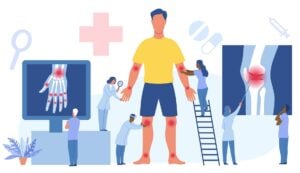

November is CRPS (Complex Regional Pain Syndrome) Awareness Month.
CRPS is a very painful, disabling, and distressing condition that usually develops in a limb after some form of trauma, such as a fracture, soft-tissue injury, surgery, stroke, or heart attack. In very rare cases, it can even develop spontaneously. Approximately 2-5% of adult pain clinic patients are diagnosed with CRPS.
There are two types of CRPS:
The overall incidence of CRPS-I occurring after a fracture has been reported at 1 – 2%, while the incidence for CRPS-II after a peripheral nerve injury is estimated to be 1 – 5%.
CRPS presents as a pattern of symptoms in the affected limb that often include a combination of the following:
Patients can present with very different signs and symptoms. Furthermore, the symptoms typically change as the condition moves from an acute to a chronic phase (after 1 year).
Unfortunately, we don’t completely understand what causes CRPS, which makes it difficult to treat. Dr Marc Russo, director of Genesis Research Services, published a hypothesis for the “pathophysiology of CRPS”, which you can read for free. Dr Russo proposed that CRPS involves a time course of four main biological processes that drive the development and maintenance of the condition, with disturbances in the immune system playing a particularly important role.

Dr Russo holds a special interest for CRPS and is dedicated to better understanding and treating the condition. He has led several clinical trials for CRPS here at Genesis, including investigational treatment studies involving new drugs and spinal cord stimulators.
We have also collaborated with basic science researchers on a study in which patients and healthy participants volunteered to have their blood taken for the purpose of “immune cell profiling”. The aim of this study was to look for differences in immune cells between patients and healthy people that might be contributing to CRPS.
With an ongoing interest in CRPS, more research studies are on the horizon. To learn more about the clinical trials conducted here at Genesis, head on over to our Join a Trial page, or view our Full List of Previous Studies. You can also register your interest for future studies.
For more information on CRPS, including an overview of treatment options, read our CRPS blog.
1. Burning Nights CRPS. https://www.burningnightscrps.org/
2. Chronic Pain Australia. https://www.chronicpainaustralia.org.au/
3. Color the World Orange for CRPS/RSD Awareness. https://www.colortheworldorange.com/
4. CRPS Network Australia. https://crpsnetworkaustralia.org.au/
5. National Organization for Rare Disorders. “Complex Regional Pain Syndrome”. https://rarediseases.org/rare-diseases/reflex-sympathetic-dystrophy-syndrome/
6. Painaustralia. https://www.painaustralia.org.au/
7. Palmer G. “Complex regional pain syndrome”. Australian Prescriber 2015; 38: 82-86. https://doi.org/10.18773/austprescr.2015.029
8. RSDSA. https://rsds.org/
9. The Purple Bucket Foundation. https://www.tpbf.org.au/
1. Russo M and Santarelli DM. “A Novel Compound Analgesic Cream (Ketamine, Pentoxifylline, Clonidine, DMSO) for Complex Regional Pain Syndrome Patients”. Pain Practice 2016; 16: E14-E20. https://doi.org/10.1111/papr.12404
2. Russo M, Georgius P, Santarelli DM. “A new hypothesis for the pathophysiology of complex regional pain syndrome”. Medical Hypotheses 2018; 119: 41-53. https://doi.org/10.1016/j.mehy.2018.07.026 (free)
3. Russo MA, et al. “Expansion and activation of distinct central memory T lymphocyte subsets in complex regional pain syndrome”. Journal of Neuroinflammation 2019; 16: 63. https://doi.org/10.1186/s12974-019-1449-9 (free)
4. Russo MA, et al. “Novel immune biomarkers in complex regional pain syndrome”. Journal of Neuroimmunology 2020; 347: 577330. https://doi.org/10.1016/j.jneuroim.2020.577330
5. Van Buyten J-P, et al. “Stimulation of Dorsal Root Ganglia for the Management of Complex Regional Pain Syndrome: A Prospective Case Series”. Pain Practice 2015; 15: 208-216. https://doi.org/10.1111/papr.12170
View our currently recruiting studies:
Register your interest for future studies:
© Genesis Research Services, 2023